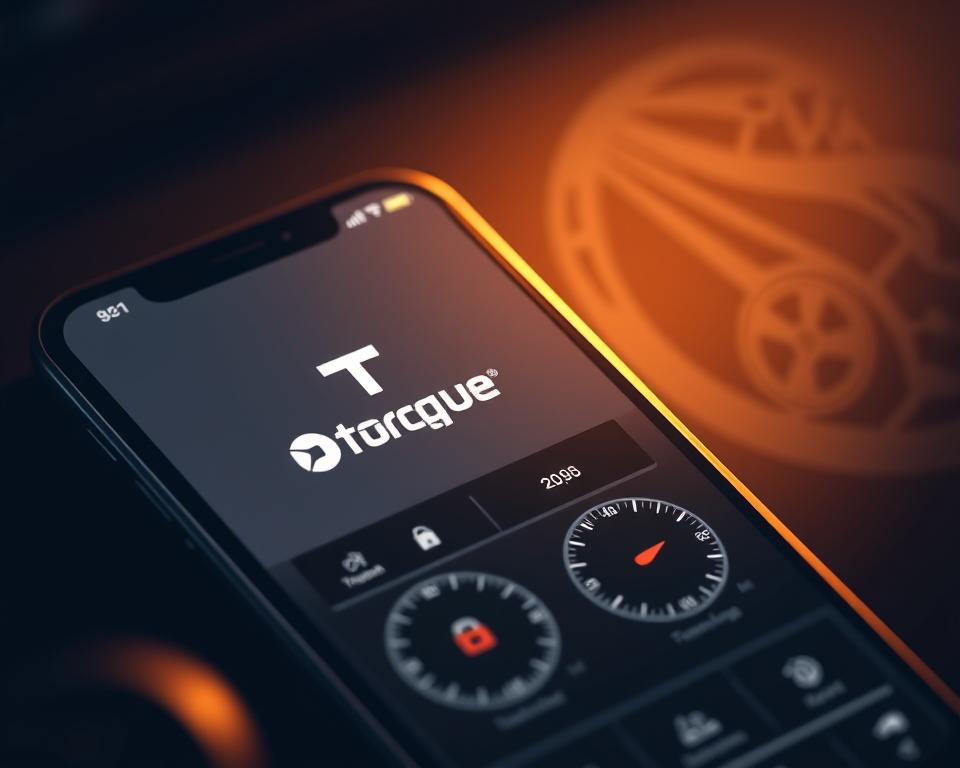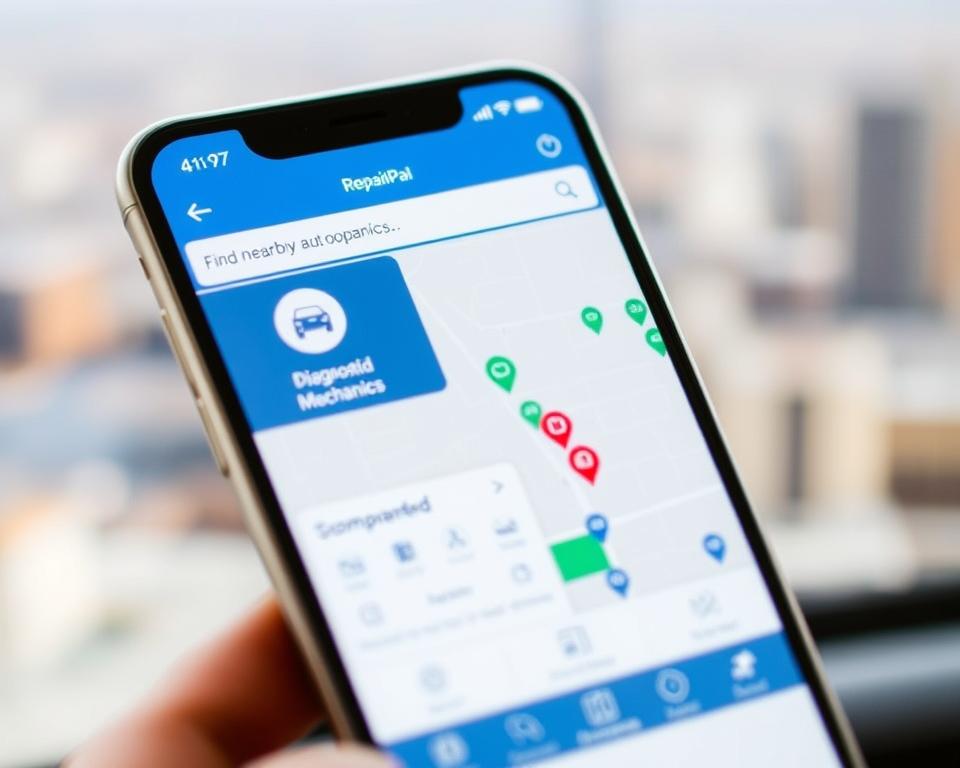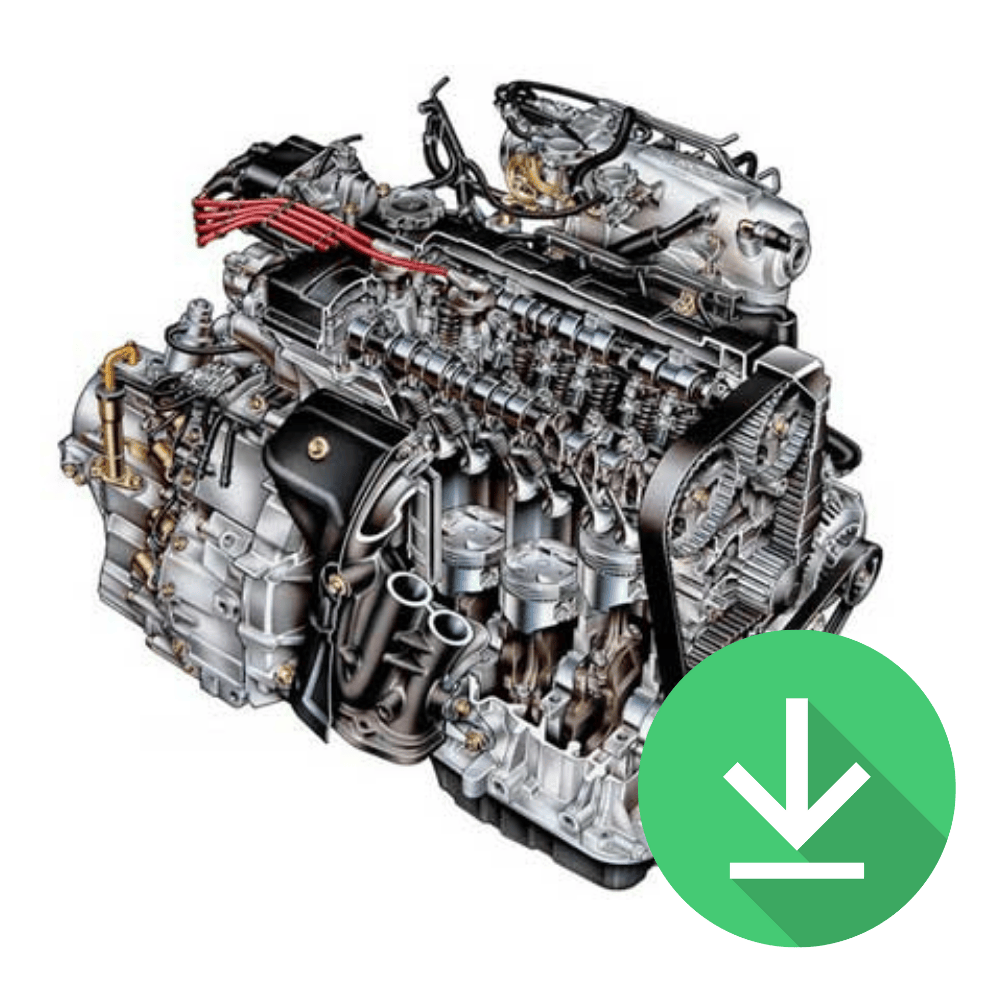Anúncios
Ever thought you could fix that rattling noise in your Toyota Camry? Or change the oil in a Honda Civic without a mechanic?
This Mechanic’s Handbook is for car owners in the United States. It’s a practical guide to auto repair. You’ll get step-by-step guides, checklists, and safety tips.
It’s easy to follow, perfect for DIY beginners and experts. Whether you drive a Ford F-150 or a Honda Civic, it helps. It offers clear fixes and maintenance tips.
Start with four cool mobile apps: Torque, RepairPal, AutoZone Repair Guide, and CarScanner. They help you read codes and do simple repairs. Then, learn about preventive care, engine checks, and more.
With this Handbook and the apps, you’ll be ready. You can do oil changes, brake pad replacements, and know when to go to a pro.
Torque

Torque Pro turns your phone into a car scanner. It shows engine data like RPM and coolant temperature. It’s great for checking problems before you look in a repair manual.
Here’s how to get the app for cars like Toyota and Honda. Always follow safety tips when using a Bluetooth adapter.
How to download Torque
On Android, search for Torque Pro in the Google Play Store. Make sure your device is compatible. Review app permissions and buy or download it.
If you have an iPhone, look for apps like OBD Fusion. Torque Pro is for Android only. You’ll need internet for the first setup.
How to use Torque
First, plug the adapter into the car’s OBD-II port. Turn the ignition to ON or start the engine.
Next, open the app and pair it with the adapter. Create a vehicle profile by entering the car’s details.
Use the app to watch data and scan for trouble codes. For example, check coolant temperature in a Ford Focus. Log fuel-trim values during a drive.
When you see codes like P0300, read what Torque says about them. Check a repair manual for more help with complex issues.
Explore advanced features like custom dashboards and GPS performance metrics. These help track your car’s performance and gather more data.
| Task | Action | Tip |
|---|---|---|
| Download | Get Torque Pro from Google Play Store on Android | Confirm device compatibility and internet access for first setup |
| Adapter | Choose a reputable ELM327-based Bluetooth OBD-II adapter | Check firmware and avoid low-quality clones for reliable data |
| Pairing | Pair phone Bluetooth with the adapter, then connect in app | Turn ignition to ON before pairing if adapter requires power |
| Vehicle profile | Enter make, model, and year in the app | Use exact model year to improve PID accuracy |
| Diagnostics | Scan, read live data, log, and clear DTCs | Cross-reference codes with a vehicle repair manual or mechanic’s handbook |
| Advanced use | Create dashboards, use GPS metrics, add plugins | Save logs for technician review or performance tuning |
RepairPal

RepairPal helps you make smart choices for car repairs. It lets you compare prices for jobs on cars like Subaru Outback and BMW 3 Series. It’s also a guide for fixing unclear car problems with trusted steps.
How to download
Search for “RepairPal” in the iOS App Store or Google Play Store. The app is free. Create an account to save quotes and searches, or use an existing one.
For a desktop view, visit the RepairPal website. There, you can print estimates and read more repair guides before going to a shop.
How to use
First, enter your car’s details: make, model, year, and trim. Then, describe the repair or symptoms, like “brake noise” or “check engine light.” The app shows a cost estimate for labor, parts, and regional prices.
Use the shop locator to compare certified shops and read reviews. The app also has auto repair instructions. These help you decide if you can do the repair yourself or if you need a pro.
Use the guide for budgeting and choosing shops. It helps you plan time and money for repairs, like replacing front brake pads on a Toyota RAV4.
AutoZone Repair Guide
The AutoZone Repair Guide helps you fix your car at home. It has step-by-step guides, diagrams, and parts lists. It works well with a vehicle repair manual.
First, download the AutoZone app from the App Store or Google Play Store. You can also find repair help on AutoZone.com. Make an AutoZone account to save vehicles and get personalized auto parts and guide recommendations.
After adding your vehicle, like a 2018 Chevrolet Malibu, you can find repair guides. These guides list tools, steps, and parts needed. You can also check if parts are available for same-day pickup.
Always follow safety notices and torque specs in the guide. For simple repairs and maintenance, the guide is great. But for complex jobs, use it with a factory service manual or a pro’s help.
Here’s a quick guide on how to use it best.
| Task | How the guide helps | Best use |
|---|---|---|
| Brake pad replacement | Parts list, step-by-step procedure, torque specs | Routine DIY with basic tools |
| Alternator swap | Diagrams, required tools, wiring notes | Component replacement and parts lookup |
| Timing belt service | Timing marks, special tool notes, safety warnings | Follow with vehicle repair manual for engine timing |
| Parts comparison | Cross-reference numbers, availability at stores | Choose correct auto parts and guides before purchase |
CarScanner
The CarScanner app makes your phone a strong OBD-II scanner. It’s great for simple checks and detailed fixes. You can see trouble codes, live sensor data, and create dashboards that fit your needs.
How to download
Find the app as “Car Scanner ELM OBD2” on Google Play and Apple App Store. Install it and pair with an ELM327 adapter or OBDLink MX+. Make sure your car is supported, like Nissan Altima or GMC Sierra.
CarScanner has a free version for basic scans. You can upgrade for more features like graphs and freeze-frame data. Pick what fits your needs and budget.
How to use
Plug the OBD-II adapter into your car, open the app, and connect. Create a car profile with make, model, and year. Then, run a scan to see DTCs and understand issues.
Watch important PIDs like intake air temperature and misfire counts. This helps find problems like a rough idle on a Hyundai Sonata. Use graphs and logs to track sensor behavior over time.
When you find a code, look up repair steps in your Mechanic’s Handbook. The CarScanner app is a useful tool for fixing your car.
Common Preventive Maintenance Tasks for Your Car
Keeping up with regular car care makes your vehicle reliable and saves money. Use this guide to help with maintenance for cars like the Honda Civic, Ford Explorer, and Toyota Tacoma. Always follow the schedule in your owner’s manual.
Oil and filter changes
Check your owner’s manual for oil change times. Times range from 3,000 to 10,000 miles, based on oil type and driving. Make sure to use the right oil, like SAE 5W-30 or synthetic.
Changing oil is easy and can be done often. First, warm the engine. Then, lift the car and remove the drain plug. Replace the oil filter and refill the oil. Check for leaks and reset the maintenance light if needed. Dispose of used oil and filters at AutoZone or a recycling center.
Tire care and rotation
Always check tire pressure and fill to the recommended level. Use the penny test to check tread depth. Uneven wear might mean your car needs alignment or suspension work.
Rotate tires every 5,000 to 7,500 miles. Use a pattern that matches your car’s drivetrain. Balance tires when new or if you notice vibration. Replace tires when wear bars show or if the sidewalls are damaged.
Brake inspection and basic service
Look at brake pads, rotors, fluid level, and hoses often. For cars like the Chevrolet Cruze, replace pads when they’re too thin, about 3–4 mm.
Replacing pads is simple. Remove the wheel, unbolt the caliper, put in new pads, and tighten the caliper bolts. Decide if you need to resurface or replace rotors. Bleed brakes right and test them at low speed before driving normally. If you have caliper or ABS module problems, get a pro.
| Task | Typical Interval | Key Steps |
|---|---|---|
| Oil and filter change | 3,000–10,000 miles | Warm engine, drain oil, replace filter, refill, check leaks, recycle used oil |
| Tire pressure & inspection | Monthly | Check pressure at cold tires, inspect tread depth, look for cuts or bulges |
| Tire rotation | 5,000–7,500 miles | Rotate pattern by drivetrain, balance if vibration, replace when worn |
| Brake inspection | Every oil service or 10,000 miles | Check pad thickness, rotor condition, fluid level, hoses; replace pads when thin |
| Brake basic service | As needed | Replace pads, resurface or replace rotors, torque caliper bolts, bleed system |
Engine Diagnostics and Troubleshooting Techniques
Good engine diagnostics save time and money. They help you find the real problem instead of just swapping parts. Start by making clear notes, then use scanners and tests to confirm your thoughts. This guide is for fixing cars at home or in a shop.
Using OBD-II codes effectively
Scanning a car shows generic and specific codes. Use a handheld scanner or apps like Torque and CarScanner. These tools give you codes, freeze-frame data, and live data. But remember, codes just show faults, not how to fix them.
P0302 means there’s a misfire in cylinder 2. Check the spark plug, ignition coil, injector, and compression. P0171 shows a lean condition on bank 1. Look for vacuum leaks, a dirty MAF sensor, or low fuel pressure before swapping parts.
Use live sensors and freeze-frame data to check a code. Compare fuel trims, oxygen sensor readings, and MAP or MAF data. This helps you avoid guessing and keeps your repair manual handy.
Symptoms-based troubleshooting
Start by writing down exact symptoms. Look for unusual noises, vibration, smoke, or loss of power. Try to reproduce issues at different speeds. This helps narrow down possible causes.
Run targeted tests based on symptoms. Misfires need cylinder balance and compression checks. Overheating requires a cooling system test. Fuel delivery issues need a fuel pressure test.
Use make-specific clues when you can. A Subaru WRX’s rough idle often means intake or vacuum leaks. A Ford 2.0 EcoBoost’s hesitation might be ignition timing or boost control faults. Keep your guide close for model-specific checks.
When to use professional diagnostic tools
Some problems need advanced tools. Bi-directional scan tools let you control actuators and monitor responses. An oscilloscope shows waveform issues on ignition coils and injectors. Smoke machines find tiny vacuum leaks.
Go to a shop for hard-to-find faults, safety system issues, or factory-level work. Dealers and seasoned technicians have tools and TSBs that home mechanics can’t match.
Use this method to link OBD-II codes, symptom analysis, and tests. It helps you move from guessing to reliable diagnosis. Use your repair manual as a trusted guide.
Electrical System Basics and Repairs
Your car’s electrical system does many things. It starts the car, charges the battery, lights up the interior, and powers many gadgets. Knowing how to fix it safely is important.
Battery testing and replacement
First, test the battery with a multimeter. A reading close to 12.6 volts means it’s fully charged. If the car is hard to start, do a load test or use a battery analyzer.
When you replace the battery, choose the right size and CCA rating for your car. Disconnect the negative terminal first, then the positive. Clean the terminals and apply dielectric grease to prevent rust. Tighten the hold-downs as the manual says.
Alternator and starter troubleshooting
To check the alternator, measure the voltage with the engine on. It should be between 13.8 and 14.6 volts. Check the drive belt for tightness and condition. Turn on lights, blower, and AC to test voltage stability.
If the voltage goes up and down or shows a lot of ripple, the alternator might need to be replaced. For starter problems, first check the battery. Look at the starter relay and connections. Do voltage drop tests in the starter circuit.
Fuse, relay, and wiring checks
Look at fuses and relays with the car’s fuse box diagram. Remove and check fuses. Use a multimeter or 12V test light to test for continuity.
For wiring repairs, look for signs of rust, damage, and loose connections. Use factory wiring diagrams for complex problems, like those in BMWs. Use the right wire gauge and connectors for repairs. If you need to fix a lot, get a professional to avoid more damage.
Transmission and Drivetrain Care
Keeping your car’s transmission and drivetrain healthy is key. It makes your car safe and saves fuel. Check your car often, like the Toyota Camry or Jeep Wrangler. Use a repair manual for the right service times and fluid types.
For automatic transmissions, check the fluid and filter. Warm the car first. Then, drain the old fluid. Replace the filter and gasket if you can.
Fill it with the right ATF, like Dexron. Check the fluid level with the engine on. Look out for slipping or hard shifts. Use a scan tool for codes and test for leaks.
Manual transmissions need clutch checks. Listen for noises and test for slipping. Check the pedal’s free play. If it’s bad, replace the clutch.
Drain the transmission and remove driveshafts. Unbolt the gearbox and replace the clutch parts. Align the clutch when putting it back together. Change gear oil and check for leaks.
Axles and CV joints need regular checks. Look for torn boots or grease loss. Replace any damaged boots. Clicking or vibration means a CV axle problem.
For differentials, change oil and check seals. Listen for whining sounds. This means worn bearings or gears.
All-wheel drive cars need special care. Check for leaks and worn joints. Use a repair manual for the right service times.
Keep a maintenance log after each service. It helps track changes and repairs. This way, you can catch problems early.
Tools, Safety, and Workspace Setup for DIY Auto Repair
Before you start, get your tools ready and set up your workspace. The right tools save time and keep you safe. This guide will help you get everything you need for DIY car repairs.
First, make a list of basic tools. Good tools are important, like for tightening and checking cars.
- Metric and SAE socket sets, deep and shallow.
- Torque wrench for correct fastener torque.
- Breaker bar and combination wrench set.
- Pliers, screwdrivers, and needle-nose pliers.
- Multimeter and OBD-II scan tool.
- Hydraulic jack plus rated jack stands; wheel chocks.
- Impact wrench optional for heavy labour; specialty tools like spring compressors when needed.
Choose tools from trusted brands. Craftsman is good for hobbyists, Snap-on for pros, and mid-range brands offer a balance. A good torque wrench and scan tool are key investments.
Wear safety gear and follow simple rules to avoid injuries. This is crucial when working on brakes, fuel systems, or electrical systems.
- Safety glasses and durable gloves for hand protection.
- Hearing protection for air tools and grinders.
- Respirator for paint, solvents, or dusty jobs.
- Protective clothing and closed-toe boots.
- Fire extinguisher rated for automotive fires within reach.
Work safely: use a flat surface, jack stands, and disconnect the battery for big jobs. Also, keep areas with fumes well-ventilated. This reduces accidents and keeps your tools in good shape.
Keep parts and fasteners organized to make reassembly easier. A clean workspace helps you work faster and reduces stress when you’re troubleshooting.
- Label small bins and use magnetic trays for bolts.
- Take photos during disassembly to record part order and orientation.
- Keep a clean parts bench for inspection and reconditioning.
- Maintain inventory of consumables: oil, filters, brake pads, and fuses.
- Store frequently used items in a small tool chest near your work area.
| Category | Items to Keep | Why It Matters |
|---|---|---|
| Hand & Power Tools | Socket sets, torque wrench, breaker bar, impact wrench | Enables safe, accurate repairs and speeds routine tasks |
| Safety Gear | Glasses, gloves, respirator, ear protection, fire extinguisher | Reduces injury risk during mechanical, electrical, and chemical work |
| Diagnostics | Multimeter, OBD-II scan tool, battery tester | Helps identify faults quickly and aligns with automotive technician handbook practices |
| Workspace & Organization | Jack stands, labeled bins, magnetic trays, parts photos | Keeps parts safe and makes reassembly predictable |
| Consumables & Maintenance | Oil, oil filters, brake pads, fuses, shop rags | Prevents delays and ensures you finish jobs in one session |
Mechanic’s Handbook: Essential Guide to Auto Repair
The mechanic’s handbook is a great tool for car repairs. It works well with your car’s manual and digital tools. It offers clear steps and quick tips for fixing your car.
How to use this handbook as your car maintenance manual
Make a folder for each car you have. Put the owner’s manual and this handbook’s key pages in it. Also, add repair logs and app diagnostics.
Stick to the maintenance schedule. Keep track of oil changes, tire rotations, and big repairs. Use the handbook to understand app codes and confirm parts and fluids.
Key chapters and reference sections to keep handy
Have quick-reference pages nearby. Include maintenance schedules, diagnostic flowcharts, and electrical troubleshooting steps. Also, have a torque specifications table.
Keep fluid capacities, fuse and relay diagrams, and common torque values handy. This makes repairs faster and more accurate.
When to consult professional technicians
Call a shop for important repairs, complex diagnostics, or big engine jobs. If it’s about warranty or recalls, a dealer or ASE-certified tech should do it.
Choose a trusted repair shop by checking RepairPal, looking for ASE certification, and reading reviews. The handbook helps you know what you can do yourself and what needs a pro.
Conclusion
Using this mechanic’s handbook with apps like Torque and RepairPal is very helpful. It turns your phone into a guide for fixing cars. You can do simple car care and find problems early.
These tools help your car last longer and save money. Doing things like oil changes and brake checks makes your car better. It also makes you feel more confident.
Remember, safety is key. Always wear the right gear and use proper tools. For big repairs, get help from certified mechanics. This keeps you and your car safe.

